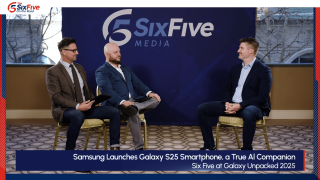The age of AI is here, and data is its fuel. But could storage limitations be holding us back? Conversations at SC24 explored this challenge diving into the SSD vs. HDD debate, and the latest advancements like Solidigm’s 122TB SSD – a game-changer that can hold 4K copies of every ’90s movie 2.6 times over! 🤯
Tune in for more on this critical piece of the AI race as Diana Blass, Patrick Moorhead, and Keith Townsend break down the latest in solid-state drive technology and their importance in AI and big data landscapes with Solidigm‘s Avi Shetty and Dell Technologies‘ Geeta Vaghela.
This episode covers👇
- The unveiling of Solidigm’s 122 TB SSD
- The growing necessity for high-density storage solutions in modern computing
- How Solidigm and Dell Technologies are addressing the AI-driven demand for data storage
- The potential impact of high-capacity SSDs on enterprise storage strategies
- Insights into future storage technologies and trends
Learn more at Solidigm and Dell Technologies.
Watch the video at Six Five Media, and be sure to subscribe to our YouTube channel, so you never miss an episode.
Or listen to the audio here:
Disclaimer: Connected is for information and entertainment purposes only. Over the course of this webcast, we may talk about companies that are publicly traded and we may even reference that fact and their equity share price, but please do not take anything that we say as a recommendation about what you should do with your investment dollars. We are not investment advisors, and we ask that you do not treat us as such.
Transcript:
Diana Blass: Welcome to the Age of AI, where data is a driving force behind innovation and storage is a refinery making it all happen. Consider this, breakthroughs like self-driving cars and personalized healthcare depend on vast amounts of data. But it’s not just about collecting it, it’s about ensuring that data is organized, secure, and accessible for tasks like training AI models, running predictions, and analyzing insights. That’s where storage comes in. And as AI grows, traditional storage methods just can’t keep up. Is the industry putting enough focus and investment towards their storage solutions right now?
Avi Shetty: Clearly not.
Patrick Moorhead: We’ve heard a lot about GPUs with generative AI. We’ve heard a lot about photonics, but there’s just not a lot of conversation about the storage element.
Avi Shetty: We believe that’s changing.
Diana Blass: Decades ago, the priority was simple. Store as much data as possible at the lowest cost, starting with punch cards, then magnetic tape and core memory. The arrival of hard dish drives in 1956 marked a turning point. HDDs revolutionized storage with faster random access to data, higher capacity, and greater durability. Over time, they became smaller and quicker, but the mechanical design couldn’t keep up with the speed and efficiency needed for today’s AI-driven workloads. Enter solid state drives or SSDs. Replacing the moving parts of HDDs with NAND flash memory, SSDs deliver faster speeds, higher reliability, and improved energy efficiency, and they can hold more data too.
Keith Townsend: So I looked this up the other day, the largest hard drive that you can get, spinning rust, 32 terabytes. You know what the largest physical SSD you can get now? I think you might have something in your hand that says it.
Diana Blass: Could it be this, 122?
Keith Townsend: 122.88 terabytes.
Diana Blass: Solidigm unveiled that SSD in November of 2024, noting that it’s enough storage to house 4K quality copies of every movie theatrically released in the 1990s 2.6 times over.
Keith Townsend: This is an insane amount of storage.
Geeta Vaghela: More than the Library of Congress or the UK library. I mean, this is huge amounts of data.
Diana Blass: But HDDs still hold value. They’re more affordable and are often thought to offer compliance advantages due to their suitability for read intensive workloads. However, Solidigm challenges this notion with its new 122 terabyte SSD, asserting that the QLC media used in its SSDs is specifically optimized for read intensive tasks. Solidigm claims this not only matches, but even outperforms traditional HDDs in such environments. So what’s next? Will SSDs ultimately replace HDDs or both continue to serve distinct roles in the evolving storage landscape? To find out, we took these questions to Supercompute, one of the world’s largest events for computing, networking, and storage. Our first stop, Dell Technologies. So when we talk about solid state drives versus hard disk drives, where do you see the market going?
Geeta Vaghela: So I think data center designs, power, cooling, performance, thermals, all of those things are coming into play. And when I think about solid state drives or HDDs, they’re sort of the foundation of a storage system. That’s what the data ultimately resides on. And so partnering with drive vendors, understanding what they’re doing, getting denser in their technologies, becoming more power efficient, that’s a huge part of how I see SSDs playing into this landscape. And we continue to see HDDs have their place as well, compliance archive type use cases. But AI right now is really pushing performance, density and capacity in terms of a data center design.
Diana Blass: It’s all to enable outcomes that can transform an enterprise. What’s that look like? Come with us. All right, we’re now outside the Dell AI factory with NVIDIA, which as you can see is a 50-foot semi truck that they somehow figured out how to get inside the Georgia World Congress Center here in Atlanta. So what’s inside? Well, let’s check it out. All right, outfit change. I made my way over to the mixed virtual reality station where I got to meet Andy again, this is Dell’s digital assistant. And what’s super cool about this headset, not only can I see a combination of real world and virtual world, but I also… Andy walked me through her, the latest server here, and then as she was showing me the device, I got to actually pick up part of it. Oh my gosh, that is so cool. Now, as we look at all those applications, think about the data, data that’s being collected, moved, processed, and trained in real time to enable those outcomes. All this happening inside that semi truck raising important questions like-
Keith Townsend: How much weight can I put inside of a truck? How much power and cooling can I put inside of a truck?
Diana Blass: Keith Townsend, CTO advisor at The Futurum Group makes a great point about storage. It’s not just about how much data you can store. Sure, AI needs systems that can handle massive amounts of data, but there’s another side to it. How much space and power these systems demand.
Avi Shetty: Think about if you’re solving for, again, an example, solving for a hundred petabyte server. If you did that with a hard drive, you would need 10 racks and consuming HDD power. With RS high-density SSDs, you can bring that down to two or maybe three racks. Thus reducing your infrastructure space, thus reducing your cooling needs and helps with overall TCR.
Diana Blass: And it comes at a pivotal moment as a tech industry and its partners grapple with how to officially power its AI solutions.
Avi Shetty: There’s one study which kind of summarizes this, I believe is from a Meta and Stanford, where they evaluated Meta’s recommendation engine and looked for storage efficiency, especially on the power side. And the study came back with 30% of power was allocated to storage in their HDD-based storage infrastructure, which essentially says that if you move from an HDD to an SSD in that domain, you had an additional 80% of power, which could be going back to your GPU to get its efficiency high.
Diana Blass: Now interestingly, 122 terabytes is so large that some vendors we spoke to say they’re not sure most clients have a real need for it now, as AI is still in its early days. Here’s sound from our interview with VAST Data, whose data platform helps all sorts of companies manage and process massive amounts of data.
Timer Hagy: We have a lot of customers that store hundreds of petabytes and sometimes at the exabyte level. Those customers can benefit a lot by shrinking that footprint. And so if you’re talking about moving from four rack units to two, maybe that’s not a lot. But if you’re talking about a room full of racks and you cut that by half, that’s significant savings.
Diana Blass: So let’s go back to our original question. Will SSDs replace HDDs? It’s always hard to predict the future, and right now it appears the consensus is that the market will be hybrid. As vendors say, it all comes down to the use case. HDDs remain a cost-effective option, especially for compliance needs. But SSDs are rapidly evolving, dropping in price, and quickly gaining market share. Now interestingly, that solid state drive that we saw released by Solidigm has already been sold out. So it’ll be interesting to see the innovation to come, especially as we look at this show floor where everybody is looking to innovate with AI. What’s on the horizon? Well, stay tuned and you’ll stay connected. I’m Diana Blass.






















































































